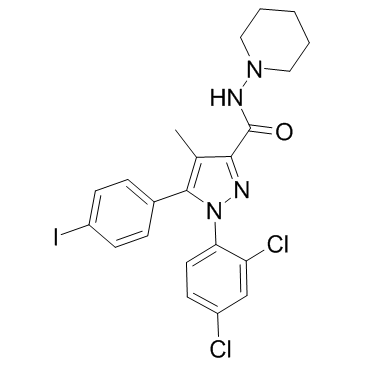AM251

AM251 structure
|
Common Name | AM251 | ||
|---|---|---|---|---|
| CAS Number | 183232-66-8 | Molecular Weight | 555.239 | |
| Density | 1.7±0.1 g/cm3 | Boiling Point | N/A | |
| Molecular Formula | C22H21Cl2IN4O | Melting Point | 195-196℃ | |
| MSDS | Chinese USA | Flash Point | N/A | |
| Symbol |

GHS07 |
Signal Word | Warning | |
|
Estrogen-related receptor α is required for efficient human cytomegalovirus replication.
Proc. Natl. Acad. Sci. U. S. A. 111(52) , E5706-15, (2014) An shRNA-mediated screen of the 48 human nuclear receptor genes identified multiple candidates likely to influence the production of human cytomegalovirus in cultured human fibroblasts, including the estrogen-related receptor α (ERRα), an orphan nuclear recep... |
|
|
Colon carcinogenesis is inhibited by the TRPM8 antagonist cannabigerol, a Cannabis-derived non-psychotropic cannabinoid.
Carcinogenesis 35(12) , 2787-97, (2014) Cannabigerol (CBG) is a safe non-psychotropic Cannabis-derived cannabinoid (CB), which interacts with specific targets involved in carcinogenesis. Specifically, CBG potently blocks transient receptor potential (TRP) M8 (TRPM8), activates TRPA1, TRPV1 and TRPV... |
|
|
2-Arachidonoylglycerol impairs human cytotrophoblast cells syncytialization: influence of endocannabinoid signalling in placental development.
Mol. Cell. Endocrinol. 399 , 386-94, (2014) A balanced cytotrophoblast cell turnover is crucial for placental development and anomalies in this process associated with gestational diseases. The endocannabinoid system (ECS) has emerged as a new player in several biological processes. However, its influe... |
|
|
The endocannabinoid anandamide induces apoptosis in cytotrophoblast cells: involvement of both mitochondrial and death receptor pathways.
Placenta 36(1) , 69-76, (2014) A balanced proliferation, apoptosis and differentiation in trophoblast cells of the human placenta is crucial for a proper placental development. Alteration in trophoblast apoptosis and differentiation are associated with gestational-related complications, su... |
|
|
Cannabinoid functions in the amygdala contribute to conditioned fear memory in streptozotocin-induced diabetic mice: Interaction with glutamatergic functions.
Exp. Neurol. 269 , 233-41, (2015) The role of cannabinoid systems in conditioned fear memory was investigated in streptozotocin (STZ)-induced diabetic mice. The cannabinoid receptor agonist WIN-55,212-2 (1mg/kg, i.p.), when injected into normal mice after conditioning, significantly prolonged... |
|
|
A Potent Systemically Active N-Acylethanolamine Acid Amidase Inhibitor that Suppresses Inflammation and Human Macrophage Activation.
ACS Chem. Biol. 10 , 1838-46, (2015) Fatty acid ethanolamides such as palmitoylethanolamide (PEA) and oleoylethanolamide (OEA) are lipid-derived mediators that potently inhibit pain and inflammation by ligating type-α peroxisome proliferator-activated receptors (PPAR-α). These bioactive substanc... |
|
|
Fine-tuning of synaptic upscaling at excitatory synapses by endocannabinoid signaling is mediated via the CB1 receptor.
Sci. Rep. 5 , 16257, (2015) The endocannabinoid 2-arachidonoylglycerol (2-AG) functions as a retrograde signaling molecule mediating synaptic transmission and plasticity at both inhibitory and excitatory synapses. However, little is known about whether 2-AG signaling is involved in home... |
|
|
Hippocampal metaplasticity is required for the formation of temporal associative memories.
J. Neurosci. 34(50) , 16762-73, (2014) Metaplasticity regulates the threshold for modification of synaptic strength and is an important regulator of learning rules; however, it is not known whether these cellular mechanisms for homeostatic regulation of synapses contribute to particular forms of l... |
|
|
Modulation of food consumption and sleep-wake cycle in mice by the neutral CB1 antagonist ABD459.
Behav. Pharmacol. 26(3) , 289-303, (2015) The brain endocannabinoid system is a potential target for the treatment of psychiatric and metabolic conditions. Here, a novel CB1 receptor antagonist (ABD459) was synthesized and assayed for pharmacological efficacy in vitro and for modulation of food consu... |
|
|
The spinal anti-inflammatory mechanism of motor cortex stimulation: cause of success and refractoriness in neuropathic pain?
J. Neuroinflammation 12 , 10, (2015) Motor cortex stimulation (MCS) is an effective treatment in neuropathic pain refractory to pharmacological management. However, analgesia is not satisfactorily obtained in one third of patients. Given the importance of understanding the mechanisms to overcome... |